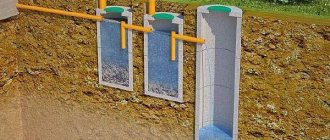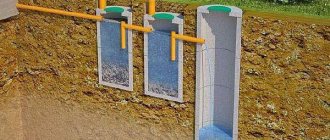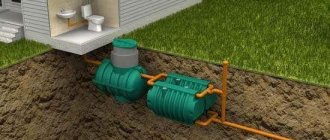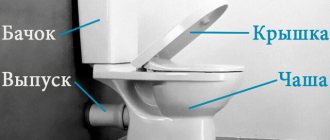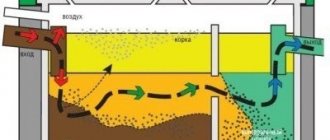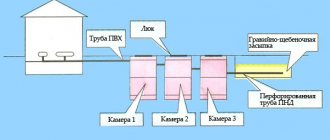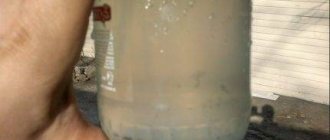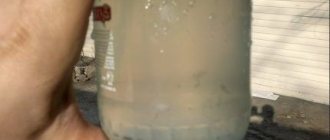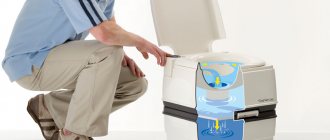Landscaping of a summer cottage presupposes the presence of a local sewerage system.
Amateur gardeners who do not live in a country house in the winter quite rightly believe that it will not be possible to build a full-fledged cleaning system cheaply.
But even for seasonal farms, there is an inexpensive and effective way to solve the problem with wastewater - use a mini-septic tank for your dacha.
Dimensions of mini-septic tanks
The size of the mini-septic tank depends on two factors:
- productivity;
- operating principle.
Anaerobic treatment plants are smaller in size than aerobic ones, since the design of the latter includes an air enrichment system (drainage pump or compressor). Additional volume is required to accommodate it.
In accordance with the intensity of sewer use, mini-septic tanks are divided into:
- universal: models with a capacity of up to 0.5 m3 per day. This volume is enough to serve a small family living in the country permanently;
- for a weekend: their volume is calculated at 0.12 – 0.15 m3/day. A septic tank of this design is considered the most optimal for summer residents who visit their properties only on holidays or weekends.
Mini septic tank
Mini-septic tanks are also available for toilets: their capacity does not exceed 120 liters per day, but they differ from other models in their lightness and miniature size. Such structures can be installed anywhere and without much labor.
In addition to volume, the choice of a specific mini-septic tank model is influenced by its geometric parameters:
- height – working chambers and full (with inspection head);
- length;
- width.
Knowing the above parameters, you can select a plot of land for installing a septic tank. You just need to take into account that the hole will have to be dug 150-200 mm more along the contour of the cross-section of the structure.
The most budget option
Many summer residents have a bathhouse and an outdoor shower on their property, so sewerage is required only for servicing the kitchen and toilet; if no more than two people live in the house, a Microbe 450 septic tank is quite suitable (it is one of the cheapest - within 10 thousand . rub.), designed for 450 liters, productivity 150 liters, and weight – 45 kg. This is the so-called weekend septic tank.
And this is how we can talk about each of them - in some respects the performance of one model is better, in others a little worse, but all deviations are within the standards.
Model selection
First of all, you need to determine the performance of the mini-septic tank. It is chosen based on:
- daily volume of wastewater;
- operating mode of the sewer system.
The volume of wastewater depends on two components:
- number of users;
- the degree of equipment of the country house with plumbing.
Mini septic tank for a summer residence without pumping
If there is no bath in the house, then for each person living in it there will be 0.15 m3/day. If there is a bath, the water consumption will increase and will be 0.2-0.25 m3/day. To calculate the total daily volume of wastewater, the above standards must be multiplied by the number of users.
In a house with permanent residence, the septic tank must accommodate a three-day volume of wastewater.
Example: for a summer house in which 2 people are constantly present, the septic tank should have a capacity of 0.15 x 2 x 3 = 0.9 m3.
Types of external sewage system for a private house
A septic tank is a tank or several tanks connected to each other, designed to accumulate wastewater and remove contaminants from it. Based on the type of operation and, accordingly, design, all wastewater disposal systems from a private home can be divided into 3 categories:
- drives;
- systems with anaerobic treatment;
- local aerobic stations ensuring maximum removal of contaminants.
The first option is the least convenient, as it requires regularly calling a sewer truck, which is most often not suitable for a summer residence and requires significant financial costs for maintenance.
Septic tank
Let's take a closer look at the two remaining types of septic tanks that do not require calling a sewer truck.
Note! No external sewage system can do without pumping. However, in aerobic and anaerobic systems it needs to be done less often, and it is not necessary to call a sewer; sometimes a sap and a drainage pump are enough.
Aerobic wastewater recovery systems
Local biological treatment plants using an aeration system (air supply) are compact versions of city-wide sewage treatment plants. Their work is divided into several stages.
- The first stage occurs in the settling tank and involves sedimentation. Large heavy contaminants end up at the bottom. Partially purified water flows through the overflow system to the next stage.
- The essence of local treatment facilities is manifested at the stage of biological treatment. In such systems, a natural process is used - the decomposition of waste by activated sludge microorganisms. Maximum purification is achieved by alternating anaerobic and aerobic phases. For the latter, air is supplied into the chamber by an aerator.
- The final stage is the sedimentation of activated sludge.
The principle of operation of a septic tank
Also, such systems are often equipped with hair catchers.
Septic tank “Topas S 12”
The output is water that is approximately 95% purified. It can be poured onto the terrain or used for technical needs. It is the high degree of purification that is the main advantage of such a system.
Note! If you want to use water from such a septic tank to care for plants, drip irrigation is recommended. It is also worth periodically checking the wastewater in the laboratory and/or installing an ultraviolet disinfectant in the treatment tail.
UV disinfection of waste
Septic tank with anaerobic treatment
Devices for treating wastewater without the use of aeration are structurally simple. They consist of one or two reservoirs connected by an overflow system and complemented by a soil filtration stage. The principle of their operation is also simple.
- The first chamber serves as a settling tank. The process of oxygen-free decomposition of organic matter also occurs here. If there is a lot of sewage, then an additional tank is installed. It continues the process of sedimentation of lighter suspended matter and anaerobic decomposition.
- Since without oxygen the degree of purification does not exceed 60%, it is unacceptable to discharge wastewater onto the terrain. For further recycling, the water enters the soil filtration stage. Here the liquid passes through the filter layer, where cleaning continues, and enters the deep layers of the soil.
Anaerobic septic tank
Note! To increase the efficiency of treatment of household wastewater and reduce the layer of dense sediment in the first chamber, it is recommended to add special bacterial preparations to the sewer system.
Bacteria for septic tanks
Prices for bacteria for septic tanks
Bacteria for septic tanks
How does it work?
The operating principle of mini-septic tanks differs little from the operation of their larger counterparts. In both cases, they purify wastewater and transfer it to filtration fields. The work flow is as follows:
- sewage flows through pipelines into the receiver of the device;
- during the settling period, the contents of the tank under the influence of gravity are divided into two fractions: large components settle to the bottom, the liquid component rises up and moves to the next compartment (if there is one) or to the filtration field;
- the remaining sediment is exposed to microorganisms, significantly decreasing in volume.
The principle of operation of a country septic tank
Undissolved residues are periodically removed by pumping.
Popular models
Among the considerable list of mini-septic tanks produced by industry, several models are in greatest demand.
Triton mini
The model is designed for constant use of sewerage by two or three residents. Made from low density polyethylene. The body is divided into two chambers. The operating principle is based on biomechanical wastewater treatment. The liquid released into the aeration field is 65% free of contaminants. There the final filtration of wastewater takes place up to 98% - the regulatory safety level.
The declared power of the Triton mini is 400 l/day. In practice, the optimal performance to avoid rapid siltation of the infiltrator does not exceed 250 l/day. This is quite enough to serve two or more people with reasonable water savings.
Model Triton mini
The volume of the septic tank is 750 liters. Its weight together with the infiltrator is 82 kg - therefore, its transportation is not difficult.
Dimensions:
- tank – 1250 x 820 x 1700 mm;
- infiltrator – 1800 x 800 x 400 mm.
The second chamber of the septic tank contains a filter with a floating bioload. Anaerobic microorganisms take part in the cleaning process.
Tank 1
The design of all Tanks is the same - they differ only in performance.
The Tank 1 model is considered a dacha option; its total volume is only one cubic meter.
Inside, the container is divided into three parts using a partition. All three compartments are connected by overflows. The strength of the body is ensured by stiffening ribs.
The first two compartments operate on the principle of a sump, the third plays the role of a biofilter using anaerobic bacteria.
Septic tank dimensions: 1200 x 1000 x 1700 mm, productivity does not exceed 0.6 m3/day. The product weighs 85 kg.
At the customer's request, Tank 1 is equipped with neck attachments that allow you to select the desired installation depth, an additional container and a pump.
Microbe
The mini-septic tank carries out biological treatment of wastewater with the participation of anaerobic bacteria. The wastewater, purified to 85%, is transferred to the infiltrator - a 400-liter container without a bottom.
The Microbes line includes 4 models that differ from each other in volume and performance:
- 450 l – 150 l/day;
- 600 l – 200 l/day;
- 750 l – 250 l/day;
- 900 l – 300 l/day.
The septic tank is made in the form of a round barrel with a diameter of 810 - 1110 mm and a height of 1430 mm. The weight of the smallest model is 35 kg, the largest – 54 kg.
Sprout mini
The two-chamber model is made of multilayer polyethylene. The first is equipped with a special damper that prevents large particles of debris from floating to the top. The second chamber contains two filters – sorption and mesh. A 200 mm layer of zeolite is responsible for adsorption.
The “mini” model in the Rostock family of septic tanks has the lowest productivity - it is only 250 l/day. The total volume of the tank is 1000 liters.
Sprout mini
Overall dimensions of the product:
- length – 1.28 m;
- width – 1.1 m;
- height – 1.7 m.
The mini sprout is lightweight - its weight does not exceed 3 kg. This fact can be considered an advantage during installation, but during operation the septic tank may “float up”.
It is advisable to provide a concrete base for its installation to which the product can be attached.
Strength
Very important for a septic tank is the tightness and strength of the structure. When choosing, special attention should be paid to the quality of the material from which the container is made. Typically, small septic tanks are made from polyethylene or propylene using rotational molding.
Due to additional stiffening ribs, even a mini plastic septic tank with thin walls will be quite strong and resistant to deformation and mechanical damage.
The thickness of the body walls of septic tanks varies from 9 to 25 mm. Of course, the thicker the plastic, the stronger and more reliable it is, but the thicker it is, the more expensive it is. The maximum thickness of the walls of the structure is more relevant for large septic tanks, which have a high risk of contour deformation under the influence of soil (when the tank is empty).
For small containers, soil pressure is also minimal, so the use of thin-walled structures, but reinforced with stiffeners, is not prohibited.
Price
Prices for mini-septic tanks depend on the performance of the product and its configuration.
For example, Triton mini costs 18,200 rubles, and complete with an infiltrator - 21,000 rubles. The cost of Microbe septic tanks is in the range of 16,500-21,000 rubles. The cheapest model is Microbe 450, the most expensive is Microbe 900.
The Tank 1 treatment plant costs on average from 20 to 29 thousand rubles, depending on the supplier.
Sellers set approximately the same price for Rostok mini - 26,000 rubles.
Do-it-yourself 2-chamber septic tank for a summer residence made of concrete rings
Excavation
Before starting construction of a septic tank, trenches and pits are marked and soil is excavated on the site. Excavation work can be done by hand or with an excavator, reducing digging time. The price for mini-excavator services is from 1,500 rubles/hour.
The dimensions of the pit are 2.0 x 4.0 x 3.0 m, which is enough to install two cameras. If you plan to install a drainage well, the length of the pit increases accordingly. The trench width is 35-45 cm, the depth is from 1.4 m to 1.6 m to create a slope and arrange a sand cushion for the pipeline.
Laying sewer pipes
To lay the pipeline, pipes with a diameter of 110 millimeters are used, which are laid on a sand bed with a slope of 5%.
Installation of concrete rings
Laying is cheaper and easier to do with a manipulator “from wheels”.
If the first well is supposed to have a monolithic bottom, the concrete solution is poured into the formwork in advance. The thickness of the fill is 10 cm. After gaining strength, they proceed directly to installation. The first ring is installed according to the design, the seam is coated with a solution. When using concrete glasses, installation work requires less time.
Further installation is carried out according to the design diagram. The joint between the concrete rings in the first tank is filled with mortar. A gravel sand filter is poured onto the base of the filtration well, and several stones can be placed between the rings for drainage.
At least 10% of the total surface area is perforated in the filtration tank.
The septic tank tanks must be connected to each other by overflow pipes with a diameter of 110 mm. We make holes for them using a hammer drill according to the project. We thoroughly coat all connections of the septic tank parts with cement mortar and cover them with liquid glass.
We install covers with hatches and a supply ventilation pipe.
After installation work, we waterproof the concrete rings, backfill the foundation pit with crushed stone, and fill the area with soil for planting a lawn or flower beds.
For moving soils, where the soil can deform the overflow pipes, it is advisable to place the tanks closely, using metal pins for fixation. Holes are drilled for them at a distance of 15 cm from the edge to avoid destruction of the rings.
***
Backfilling of pits and trenches is carried out with sand and gravel only after checking the tightness of the pipeline. If water leaves the pipeline at a speed higher than the standard, you need to check and insulate the joints, and then re-check the tightness.
***
Reviews
In general, users evaluate the performance of mini-septic tanks very positively. Thanks to them, owners of small dachas were able to abandon primitive cesspools.
At the same time, owners are concerned about the need to regularly clean sedimentation tanks, but the manufacturers are to blame for this - they advertise their products too aggressively, promising to save the user from any hassle. In fact, compared to a cesspool, the number of pumps is significantly reduced, but the need for them does not disappear forever.
Phone numbers of managers, engineers and executives
Wholesale sales department (Moscow office)
8
for dealership and wholesale purchases
Retail sales department (Moscow office)
8
Tatyana Kataeva
8
Olga Sergutina
8
Anastasia Svertneva
Regional warehouse of Triton Plastic LLC - manufacturer of Septic Tank in Krasnodar
8
(free call within Russia)
Regional warehouse of Triton Plastic LLC - manufacturer of Septic Tank in Lipetsk
8
(free call within Russia)
Regional warehouse of Triton Plastic LLC - manufacturer of Septic Tank in Vladimir
8
(free call within Russia)
Regional warehouse of Triton Plastic LLC - manufacturer of Septic Tank in Volgograd
8
(free call within Russia)
Regional warehouse of Triton Plastic LLC - manufacturer of Septic Tank in Vologda
8
(free call within Russia)
Regional warehouse of Triton Plastic LLC - manufacturer of Septic Tank in Voronezh
8
(free call within Russia)
Regional warehouse of Triton Plastic LLC - manufacturer of Septic Tank in Kazan
8
(free call within Russia)
Regional warehouse of Triton Plastic LLC - manufacturer of Septic Tank in Kursk
8
(free call within Russia)
Regional warehouse of Triton Plastic LLC - manufacturer of Septic Tank in Rostov-on-Don
8
(free call within Russia)
Regional warehouse of Triton Plastic LLC - manufacturer of Septic Tank in Samara
8
(free call within Russia)
Regional warehouse of Triton Plastic LLC - manufacturer of Septic Tank in St. Petersburg
8
(free call within Russia)
Regional warehouse of Triton Plastic LLC - manufacturer of Septic Tank in Smolensk
8
(free call within Russia)
Regional warehouse of Triton Plastic LLC - manufacturer of Septic Tank in Yaroslavl
8
(free call within Russia)
